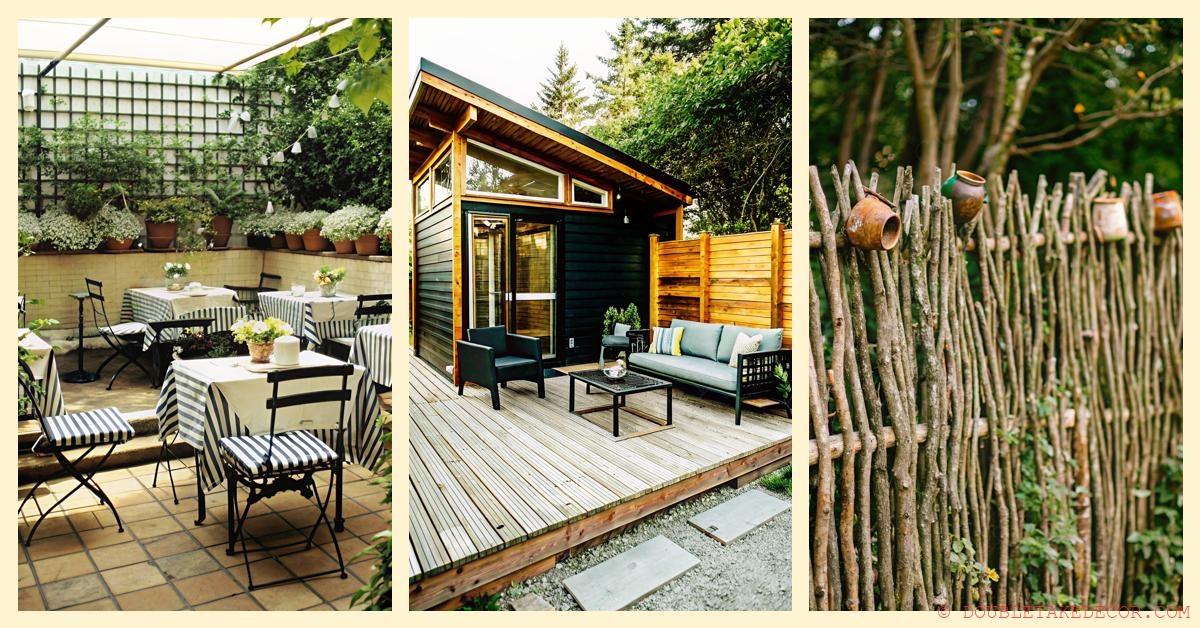
Transform your outdoor spaces with creative potted plant arrangements that breathe life into porches, patios, and balconies. By combining colorful blooms, rich foliage, and containers with distinct character, you can craft captivating displays that serve as focal points in your garden design.
The beauty of container gardening lies in its versatility and adaptability. From heat-tolerant annuals in summer to chrysanthemums in fall, seasonal selections ensure year-round appeal. Unconventional containers like galvanized tubs, vintage watering cans, or repurposed wooden crates add personality while providing practical growing spaces.
Creating visual interest is all about thoughtful composition. Layer plants of varying heights, mix trailing varieties with upright specimens, and play with contrasting textures and colors. Consider using a soilless mix for optimal drainage and aeration, preventing common issues like root rot while promoting healthy growth.
Whether you’re crafting privacy screens with tall ornamentals, designing rustic vignettes that tell a story, or maximizing limited space with vertical arrangements, potted plants offer endless possibilities. By grouping containers of different sizes, incorporating seasonal elements, and expressing your personal style through creative combinations, you’ll create outdoor displays that delight throughout the year.
- 🌿 Versatile Container Gardening: Potted plant arrangements can transform outdoor spaces like porches, patios, and balconies by using vibrant blooms, rich foliage, and unique containers to create captivating focal points.
- 🍂 Seasonal Adaptability: Incorporate heat-tolerant annuals in summer and chrysanthemums in fall to ensure year-round appeal, using unconventional containers for added personality and practical growing spaces.
- 🎨 Creative Composition: Enhance visual interest by layering plants of varying heights, mixing trailing with upright varieties, and playing with contrasting textures and colors to craft a dynamic and cohesive display.
- 🏡 Endless Possibilities: From creating privacy screens with tall ornamentals to designing rustic vignettes, potted plants offer a myriad of possibilities to express personal style and enhance outdoor aesthetics throughout the year.
Vibrant Patio Container Garden
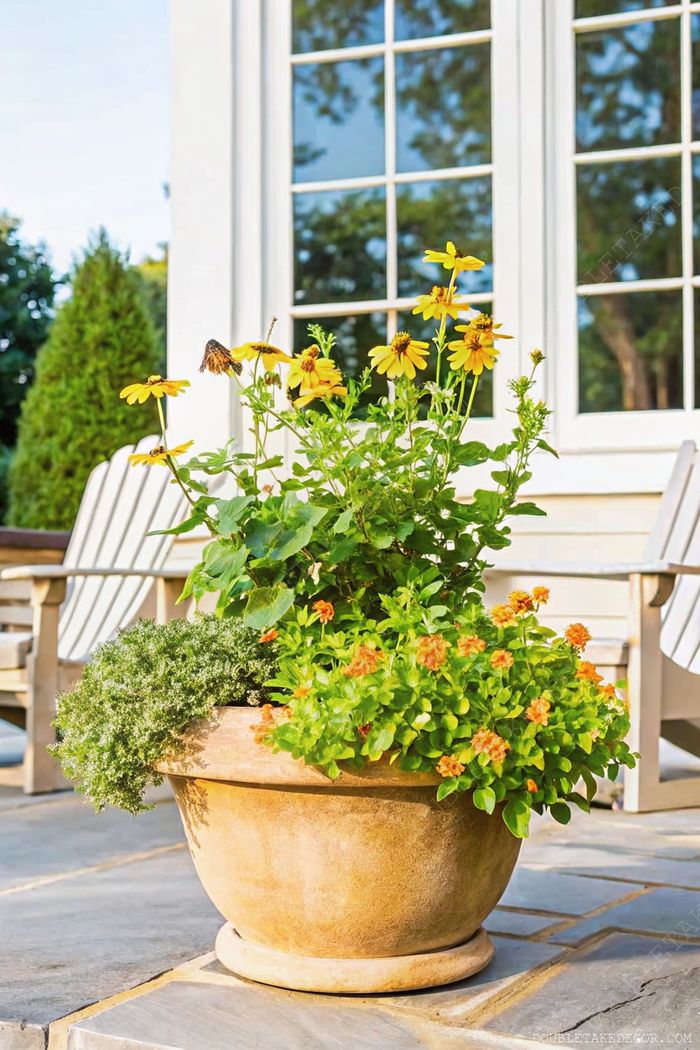
Maximize curb appeal with a terracotta planter filled with complementary colors. Combine bold Black-eyed Susans with trailing greenery and clusters of orange blooms for visual interest. Place your container garden near seating areas to create a welcoming atmosphere. Water deeply but infrequently to encourage strong root development in outdoor planters.
Terracotta Pots with Blue Flowers
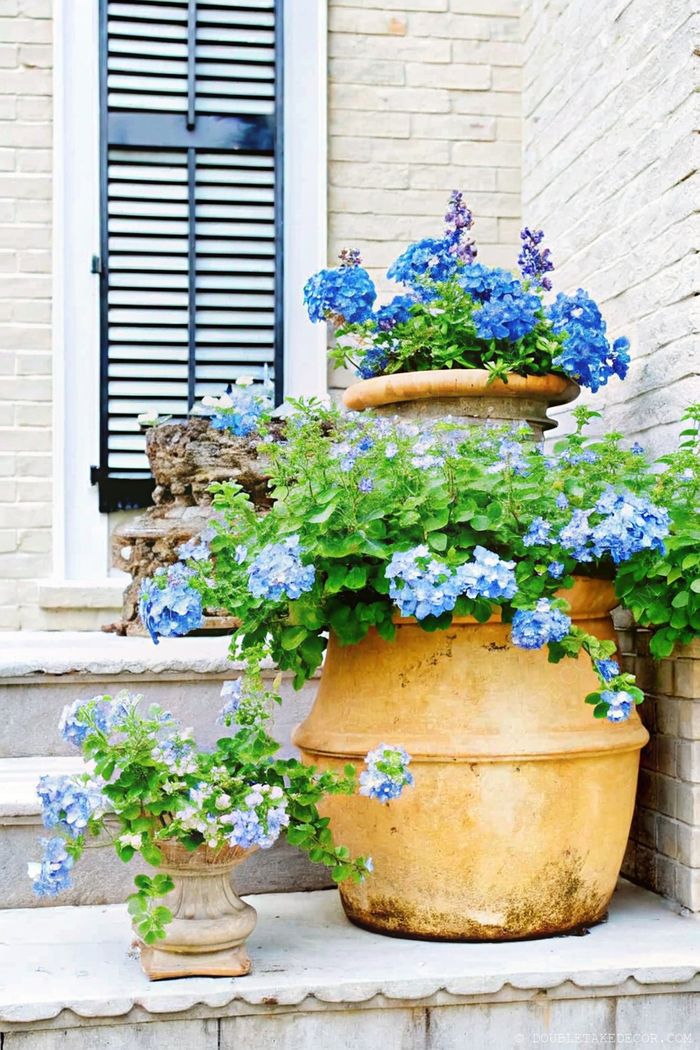
Create a welcoming entrance with cascading terracotta planters. Position a larger pot as the focal point with a smaller companion pot for visual balance. Choose vibrant blue flowers for striking contrast against the warm clay. Arrange against textured walls to enhance the Mediterranean appeal. Water thoroughly but allow drainage to prevent root rot.
Colorful Entryway Potted Arrangement
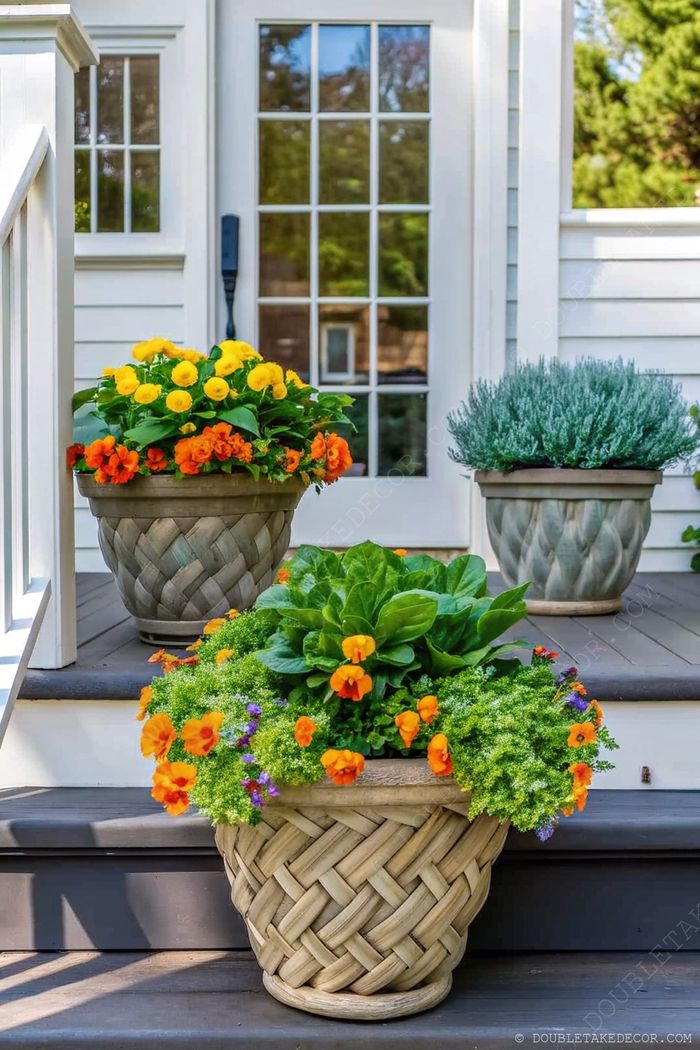
Create a welcoming entryway by placing pots in varying heights and textures. Combine vibrant flowering plants with softer foliage varieties for visual interest. Position the largest, most colorful arrangement as your focal point, then add complementary plants in smaller containers. This tiered approach draws the eye and maximizes curb appeal.
Colorful Ceramic Planter Arrangement
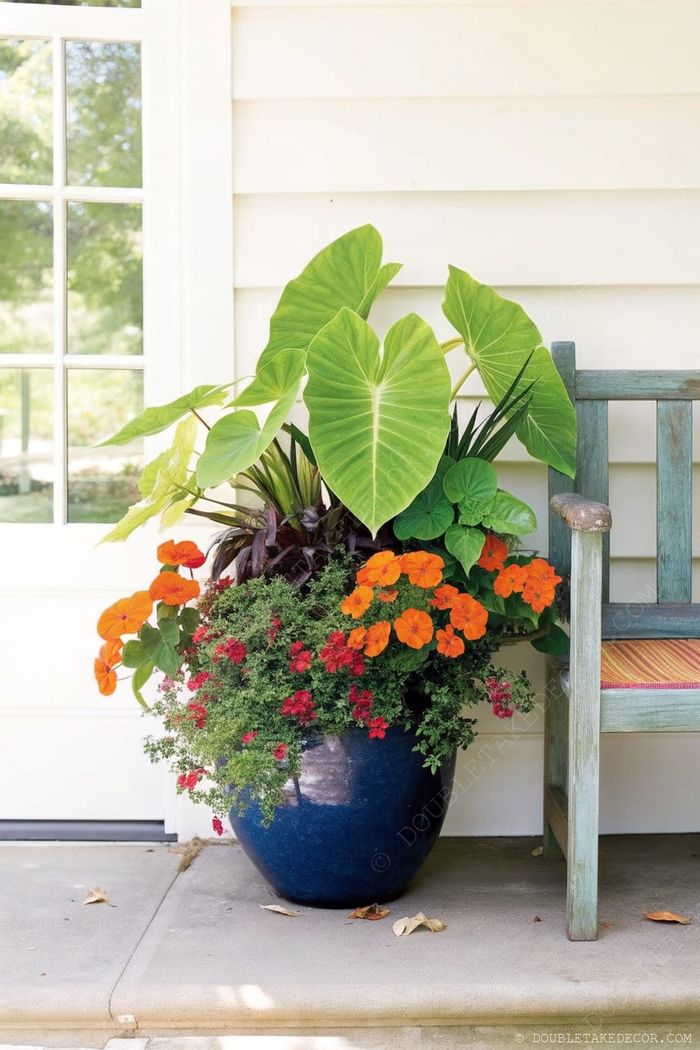
Create an inviting entryway by pairing a large blue ceramic planter with vibrant orange and red blooms. Balance the arrangement with cascading greenery for texture and depth. Position next to a complementary piece of furniture, like this distressed teal chair, to establish a cohesive outdoor vignette that welcomes guests with colorful charm.
Hanging Galvanized Planter with Blooms
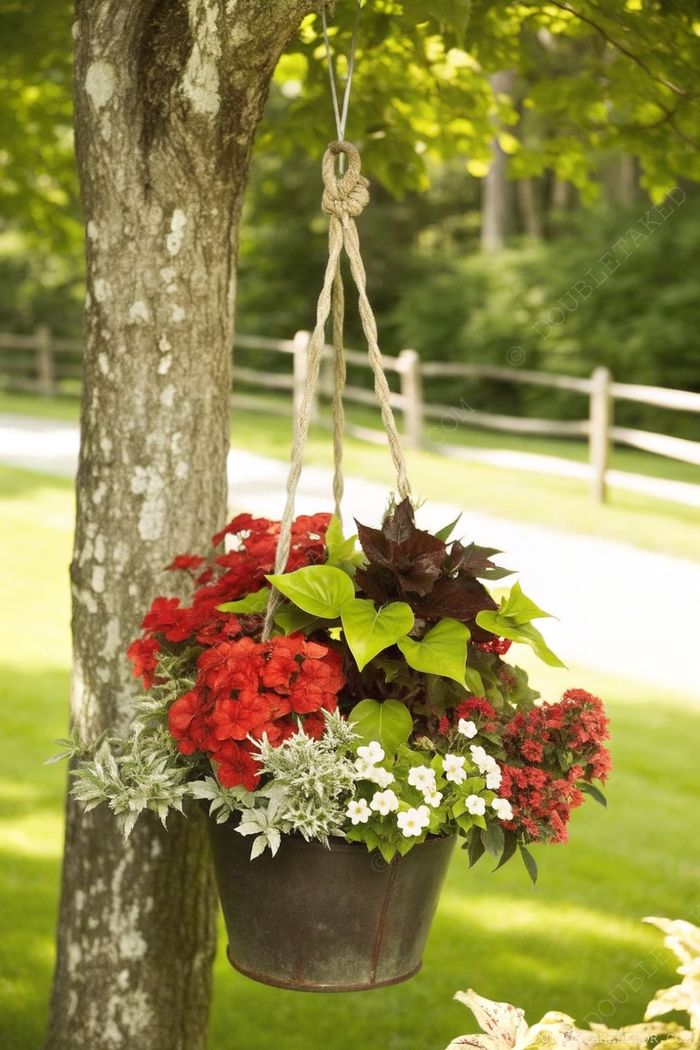
Maximize your outdoor vertical space by suspending galvanized metal planters from sturdy tree branches. Combine red, white blooms with cascading greenery for visual impact. This arrangement works beautifully in gardens with limited ground space. Ensure proper drainage and regular watering, as hanging planters can dry out quickly in direct sunlight.
Garden Patio With Terracotta Centerpiece
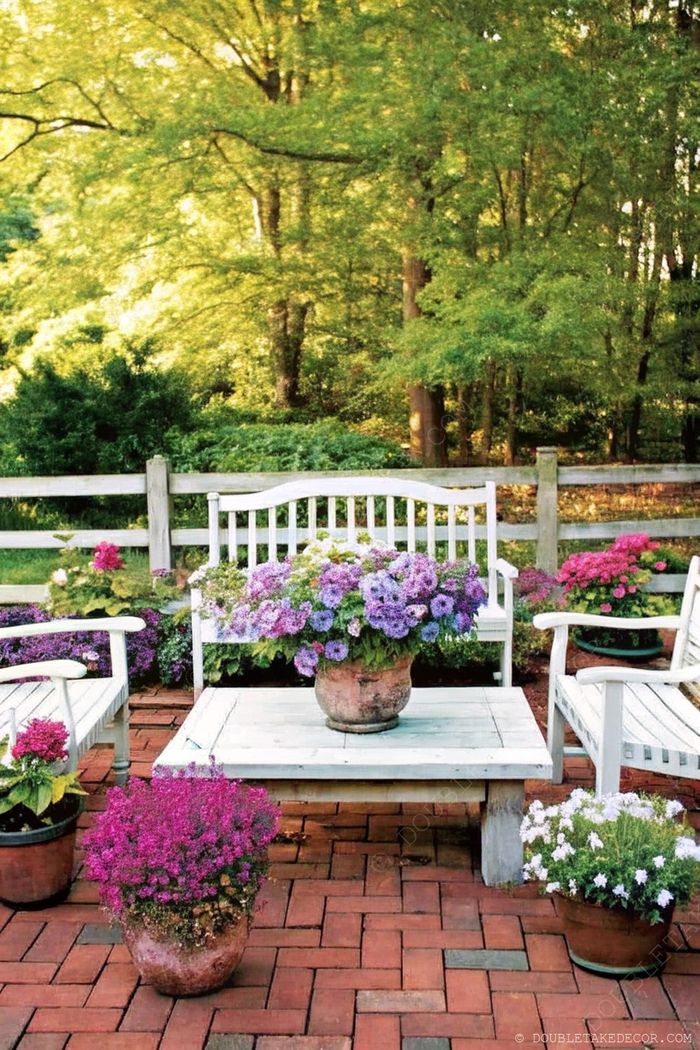
Create a focal point on your outdoor table with an overflowing terracotta pot arrangement featuring purple blooms. Position complementary potted plants around the perimeter of your seating area to establish a cohesive look. The brick paving offers practical contrast while enhancing the natural aesthetic of your garden retreat.
Terraced Porch Plant Display
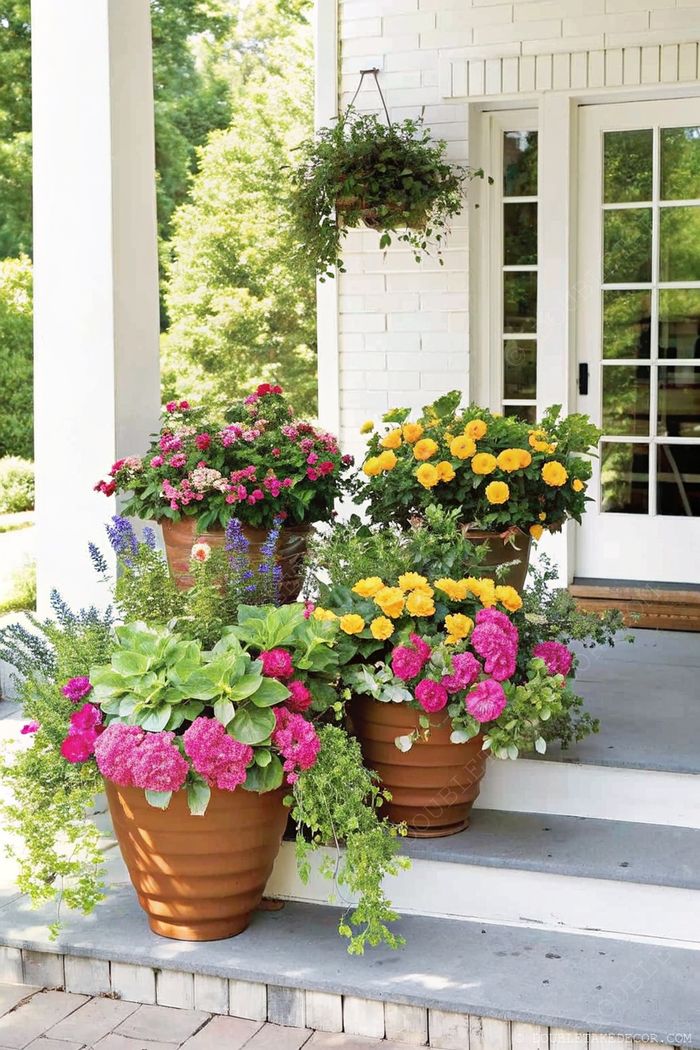
Arrange potted plants on porch steps to create a dynamic, welcoming entrance. Place larger terracotta containers on lower levels with smaller pots above for visual balance. Incorporate varying flower colors for contrast against white brick. Include hanging baskets to draw the eye upward and extend your display vertically. Ensure proper spacing for easy step access.
Greenhouse Table Display with Tulips
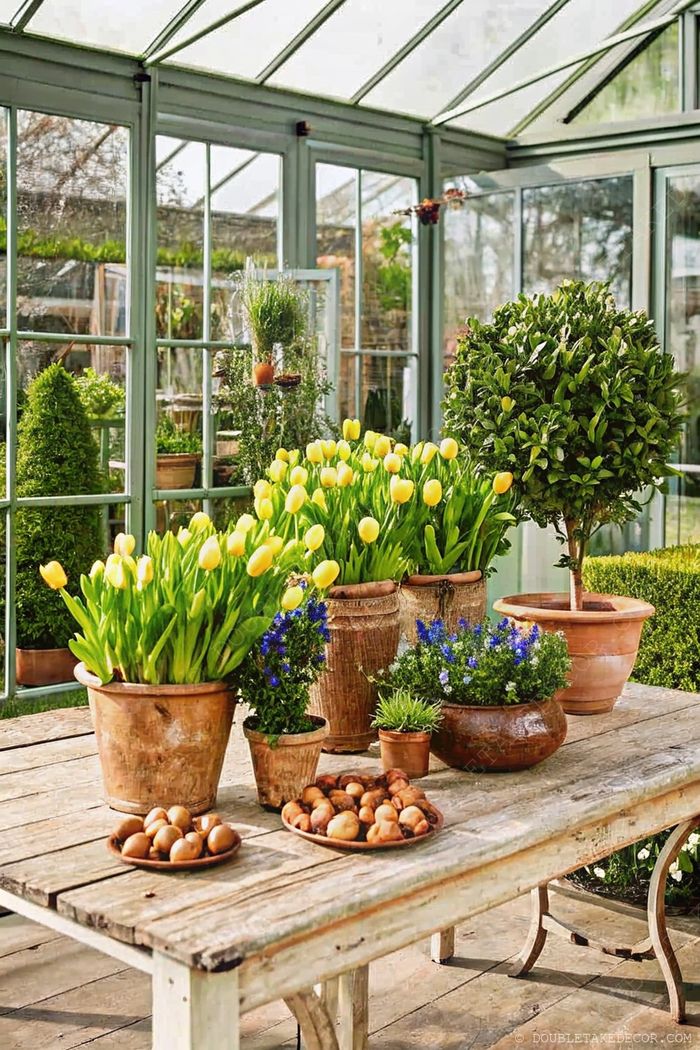
Arrange terracotta pots of yellow tulips and blue blooms on a rustic wooden table for a cheerful greenhouse display. Include decorative elements like a plate of colorful eggs to enhance the natural charm. Position your table where natural light can illuminate the plants, creating depth with varied heights and greenery types.
Tiered Entryway Basket Display
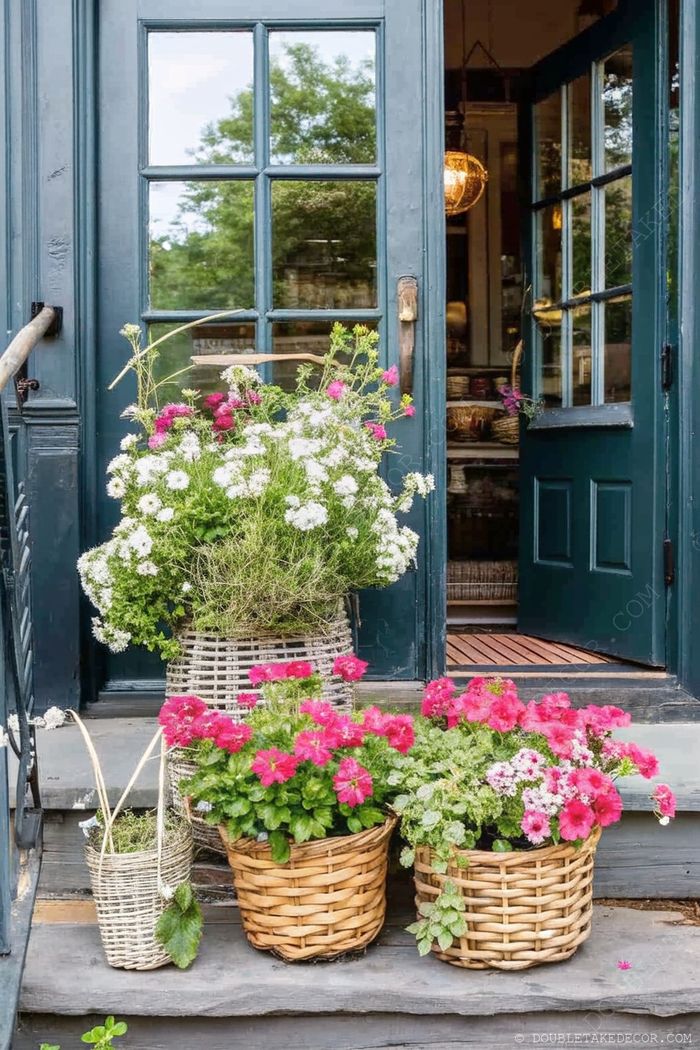
Arrange wicker baskets filled with complementary flowers and greenery on your entryway steps for a tiered visual effect. Place the largest container at the bottom for stability, creating a gradient of heights. Combine white blooms with colorful petunias for contrast against darker doors. Refresh plants seasonally to maintain this welcoming display year-round.
Tiered Stone Wall Plant Display
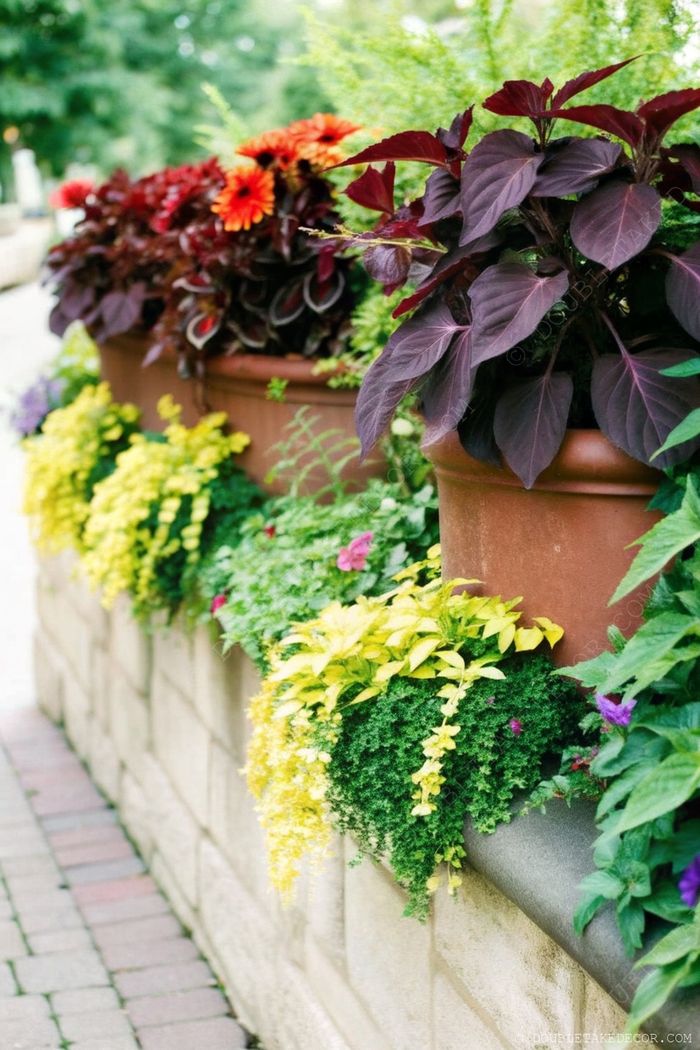
Maximize vertical space with a multi-level stone wall planting arrangement. Combine bright flowering plants with cascading varieties for visual interest. Alternate terracotta pots of different sizes for a balanced look. Include contrasting foliage colors—purple, yellow and green—to create depth. Position this display along garden pathways for maximum enjoyment from multiple angles.
Seasonal Patio Planter Display
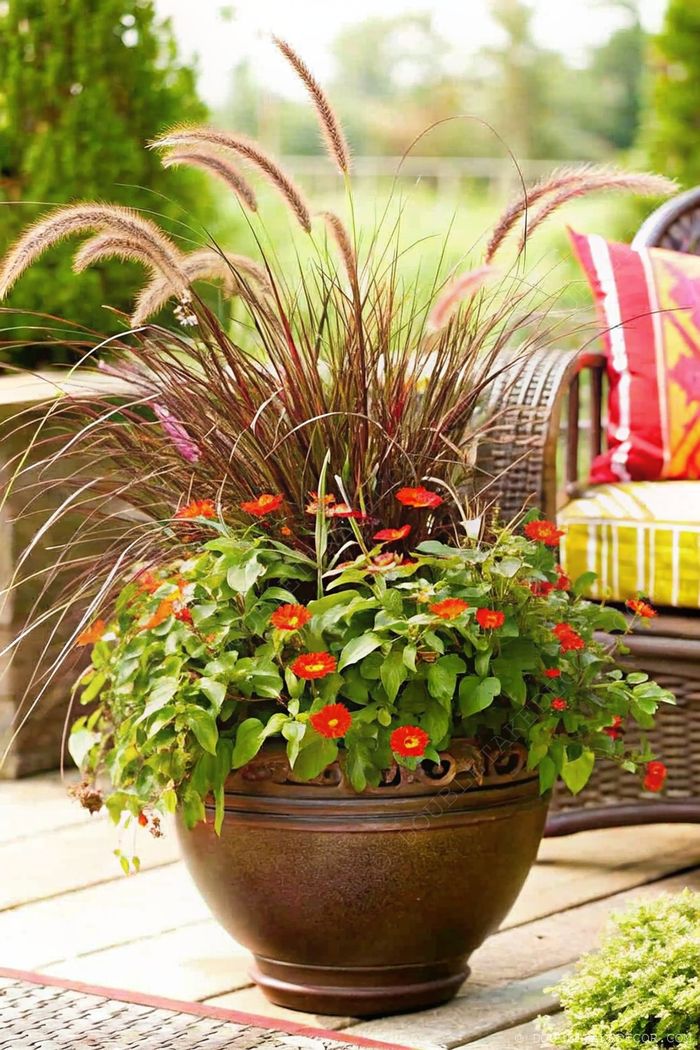
Combine vertical foliage with vibrant blooms in a decorative container for striking visual impact. Layer tall ornamental grasses behind orange flowering plants to create depth. Choose a planter with architectural details that complements your outdoor furniture. Position near seating areas to enhance the ambiance while maintaining comfortable traffic flow.
Textured Red Planter with Varied Foliage
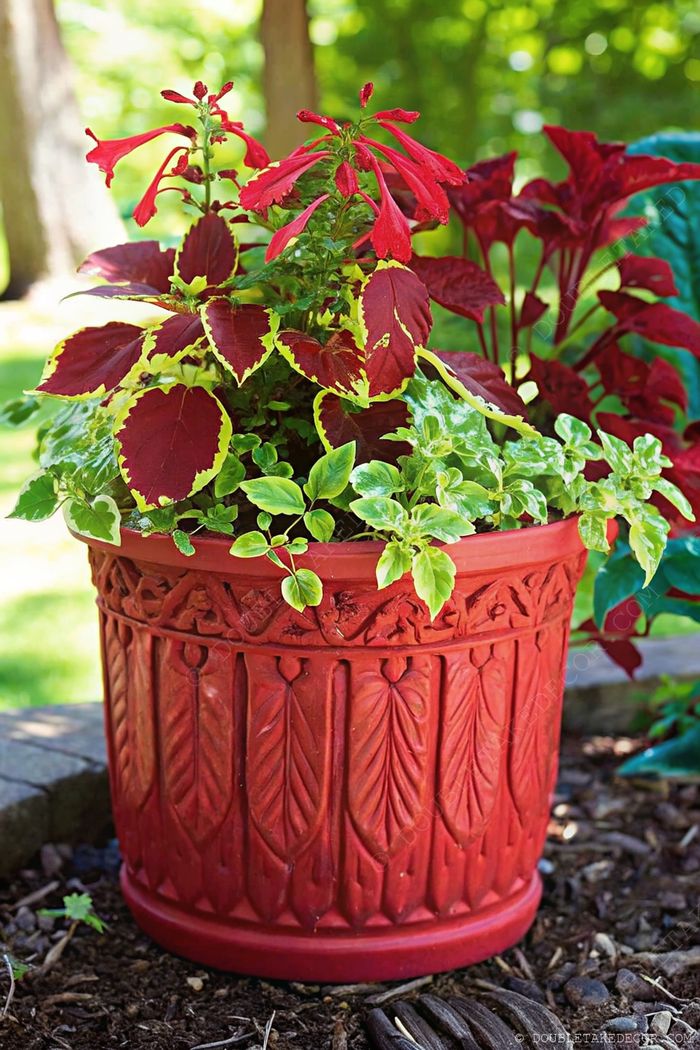
Create visual impact by combining plants with contrasting colors in a decorative planter. Select varieties with different leaf shapes and heights for dimension. Position red-leaved specimens centrally as focal points, surrounded by complementary greens. Water according to each plant’s specific needs rather than on a fixed schedule for optimal growth.
Vibrant Terracotta Pot Plant Arrangement
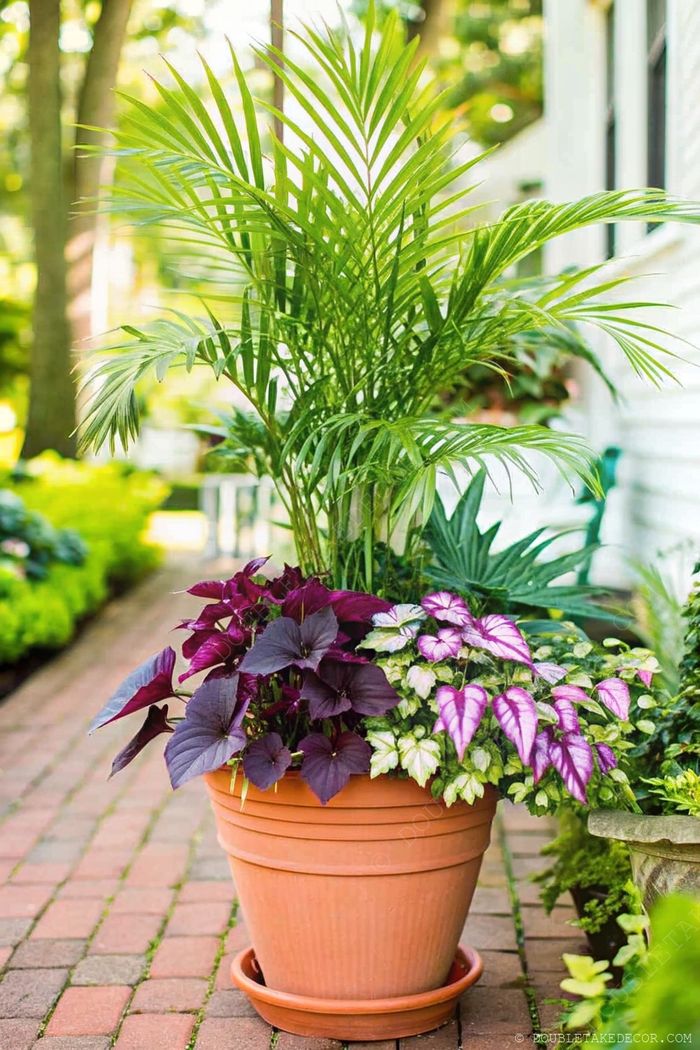
Combine varying heights by positioning a tall palm as the centerpiece, surrounded by contrasting purple and pink foliage plants. This layered approach creates visual interest while maintaining balance. Use this arrangement to transform plain pathways or patios into striking focal points. Ensure proper drainage in your terracotta pot for optimal plant health.
Rustic Bench with Vibrant Flower Pot
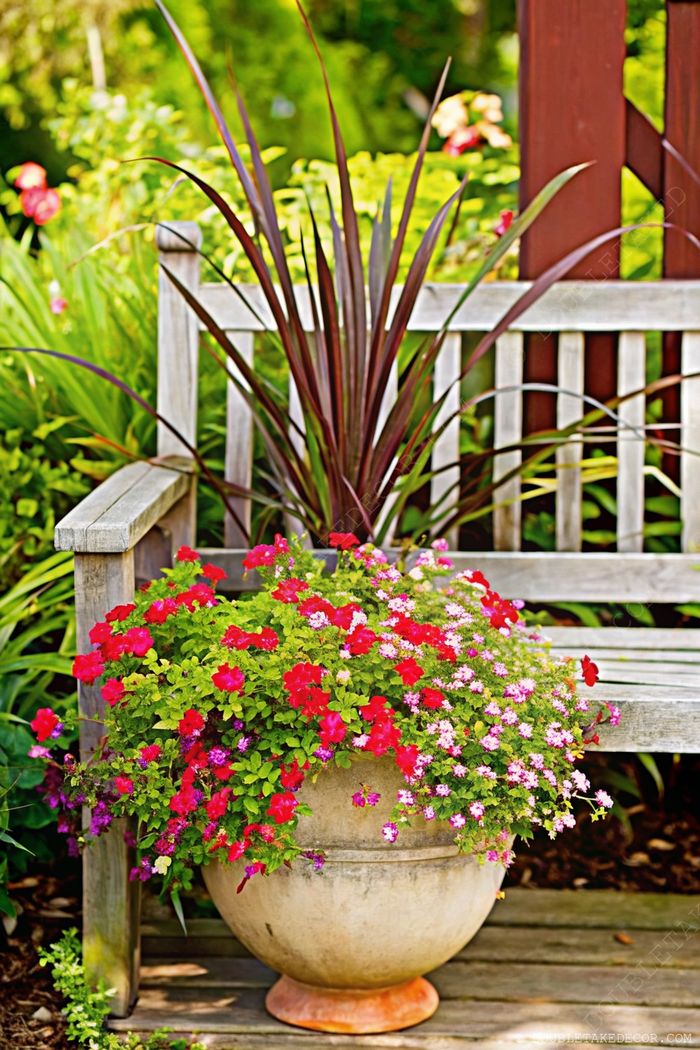
Create a serene garden retreat by placing a large terracotta pot bursting with colorful blooms in front of a weathered wooden bench. Combine flowers in complementary hues with tall, slender plants for dimension. This arrangement offers both visual appeal and a tranquil spot to enjoy nature. Position in a garden corner for maximum impact.
Staggered Basket Planters on Steps
Arrange textured basket planters at different heights on wooden steps to create depth and visual interest. Choose complementary colors like lavender and pale pink to enhance your garden aesthetic. Fill with contrasting foliage and small flowering plants for a cohesive look. This arrangement works beautifully for entryways or patio corners.
Vibrant Multi-Colored Container Garden
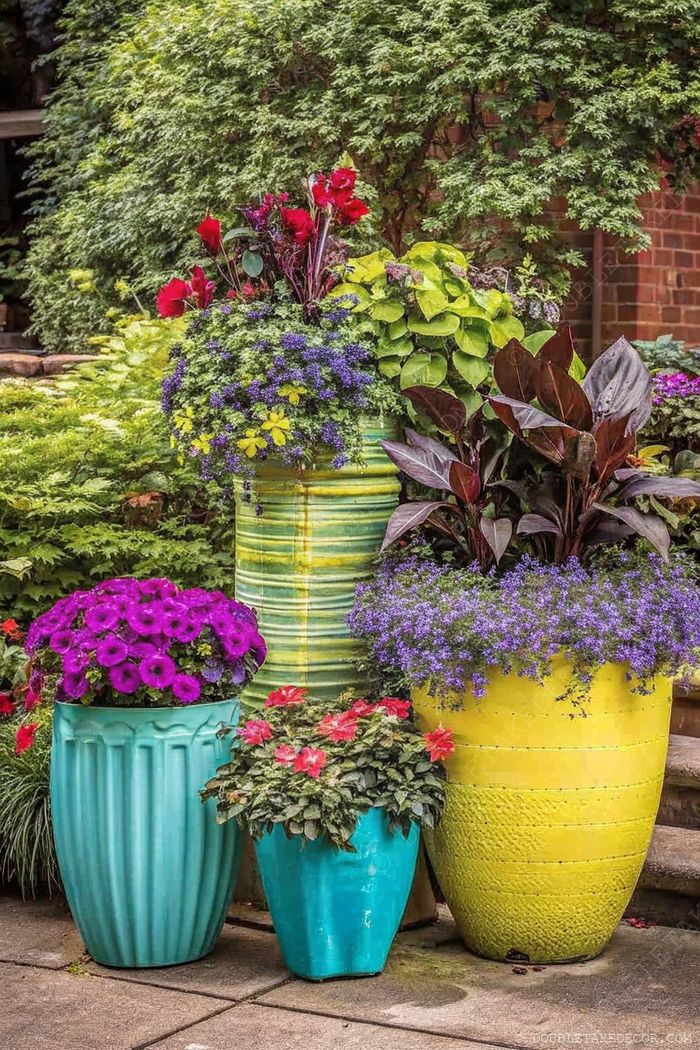
Create a striking visual focal point by arranging oversized pots in contrasting colors like turquoise, yellow, and purple. Plant each container with complementary blooms—try petunias in purple pots and red flowers against turquoise. Vary heights and sizes for dimensional interest. Position against green foliage for enhanced visual impact in any garden space.
Yellow Succulent Planter with Concrete Base
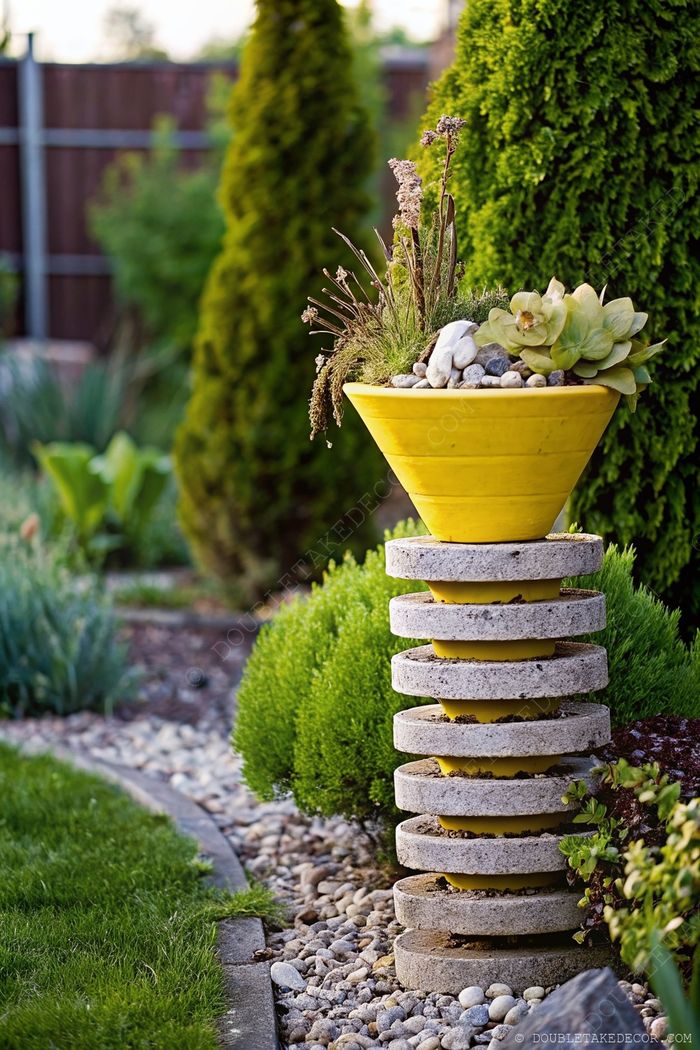
Elevate your garden’s aesthetic by mounting a vibrant planter on stacked concrete discs. This creates a striking focal point that draws the eye upward. Use contrasting elements like colorful ceramics against neutral concrete to enhance visual appeal. Surround with complementary greenery and decorative pebbles for a polished, designer look.
Tiered Porch Plant Display
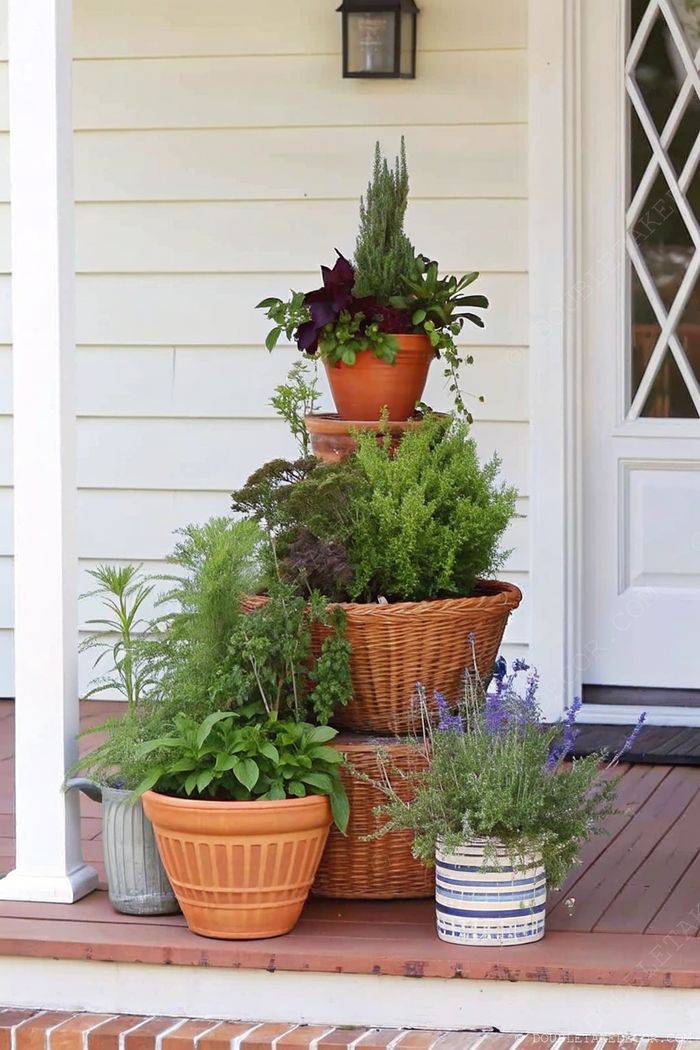
Create a dynamic outdoor space by arranging plants at varying heights using terracotta pots and woven baskets. Combine upright herbs at the top, mixed foliage in the middle, and lush greenery in larger containers at the bottom. Incorporate different pot colors and textures for visual interest while maintaining a cohesive look.
Tropical Entrance Planter Arrangement
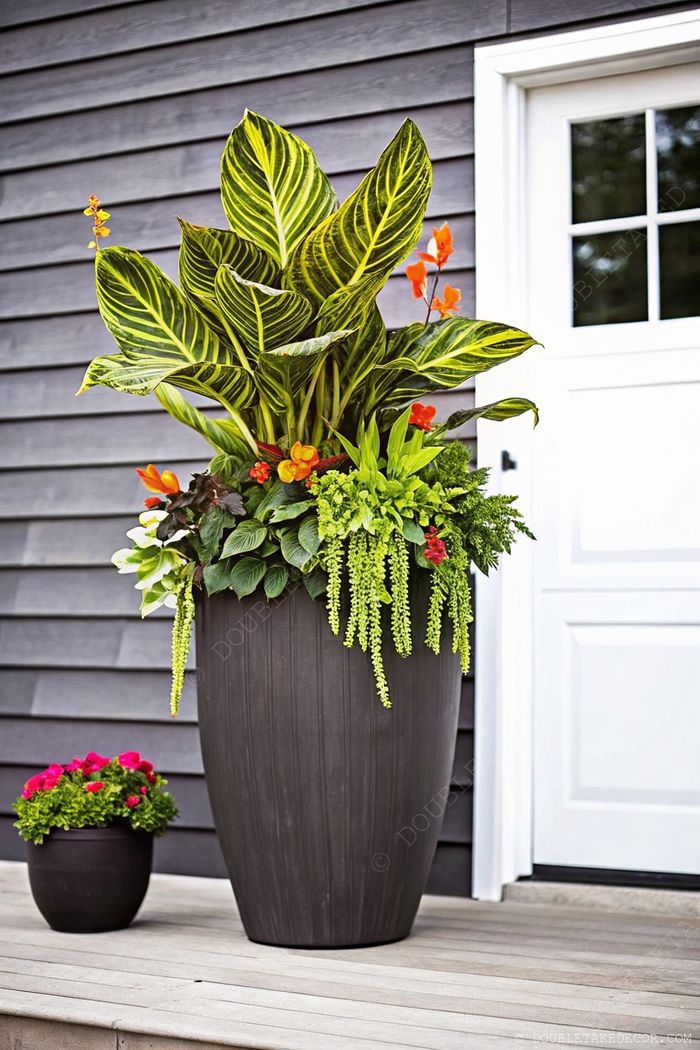
Create a grand welcome with varying heights and textures in your entrance planters. Pair a tall ribbed container featuring tropical foliage and orange-yellow blooms with a complementary smaller pot of vibrant pink flowers. Allow cascading greenery to soften edges and establish visual flow. Position against dark surfaces for maximum contrast and visual impact.
Turquoise Shutters with Cascading Planter
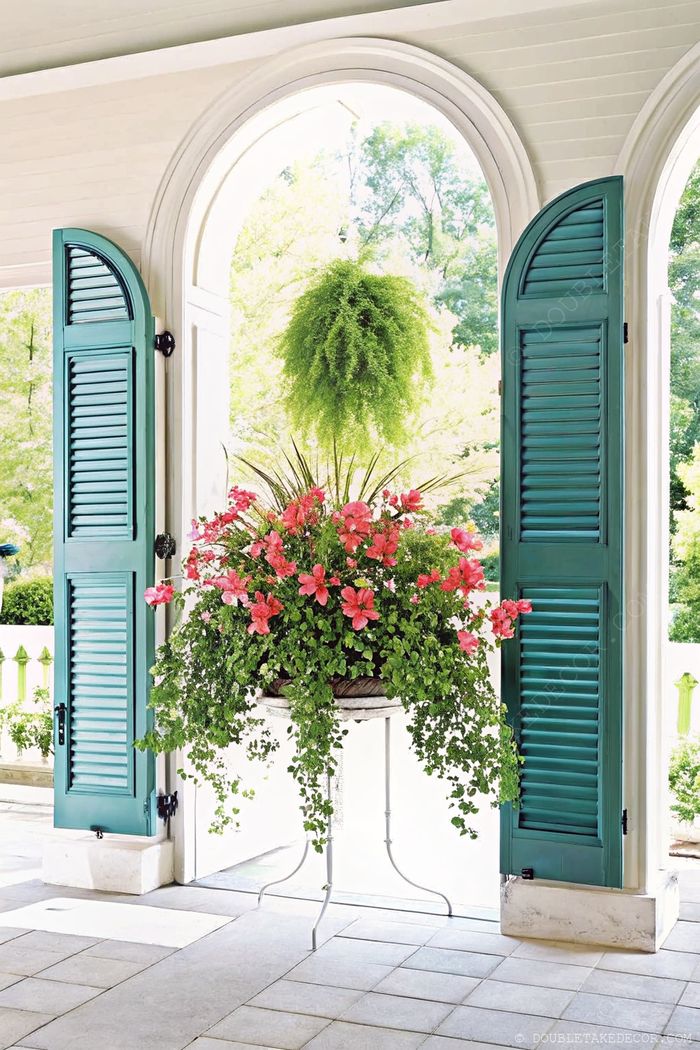
Frame architectural features with strategic plant placement. Position a vibrant planter with cascading flowers near decorative elements like these turquoise shutters to create visual harmony. The contrast between structured architectural elements and natural foliage adds depth and character to your space. Use trailing plants to soften hard edges.
Layered Corner Plant Display
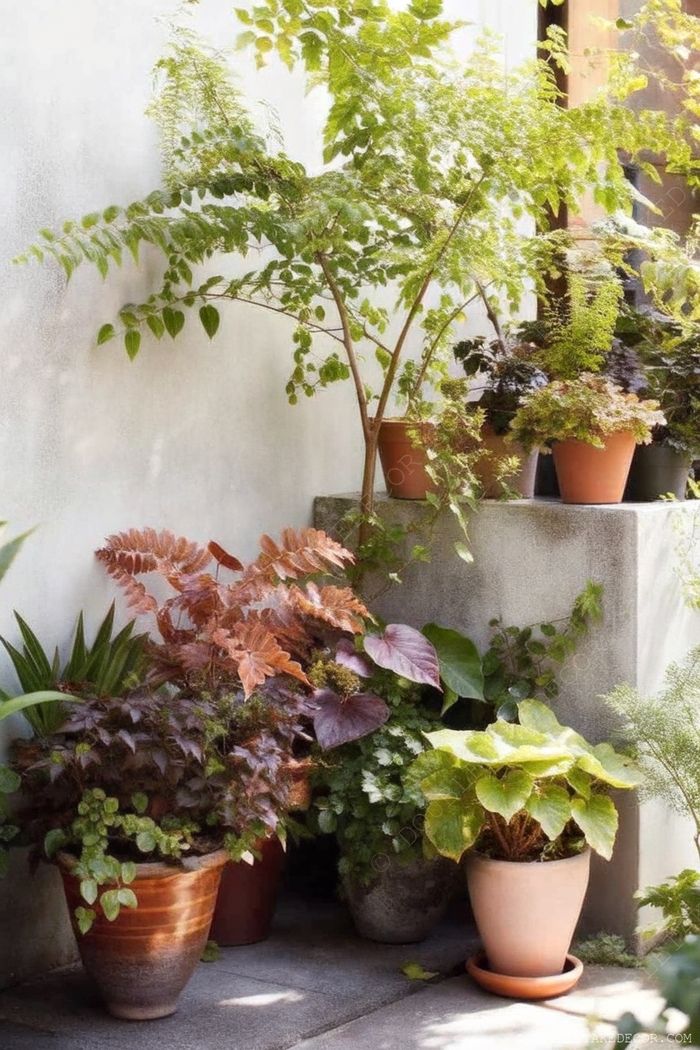
Create depth in your indoor garden by arranging plants at various heights. Position taller specimens like slender trees against walls, then layer medium and small plants in front. Mix terracotta with concrete planters for textural interest. Combine different leaf shapes and colors for visual diversity while maintaining a cohesive green palette.
Turquoise Door with Planters
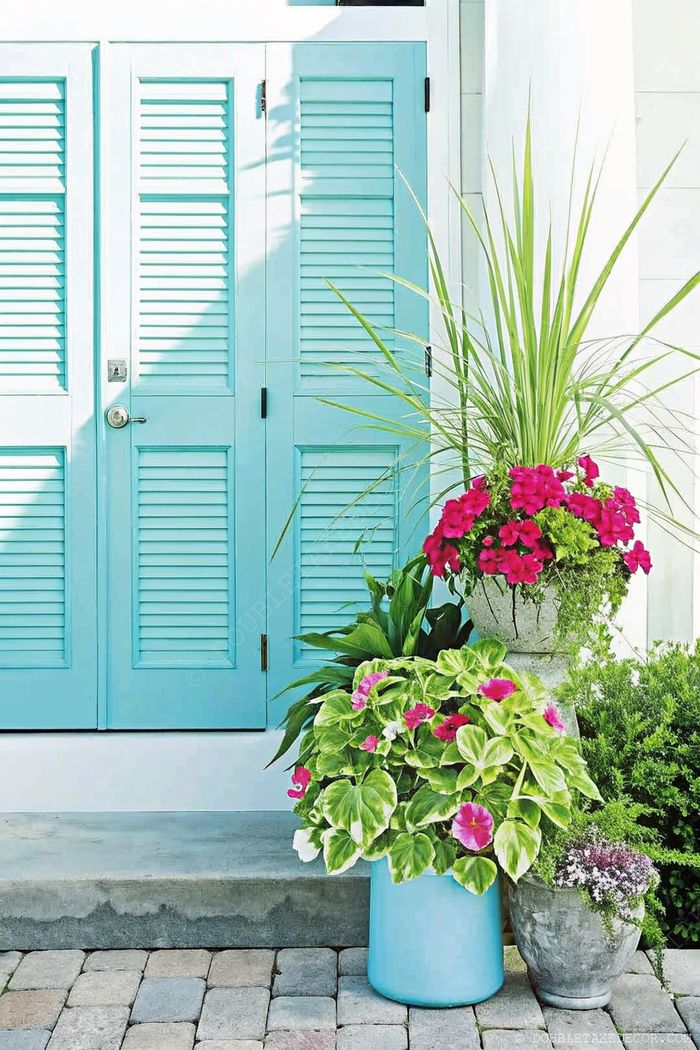
Enhance your entryway with mixed-height potted arrangements. Place a taller planter with ornamental grasses alongside a shorter, rounded vessel filled with trailing plants. Choose complementary pot colors that echo your door or trim accents for a cohesive look. Use variegated foliage and bright blooms to maintain visual interest year-round.
Vibrant Mixed Plant Container Garden
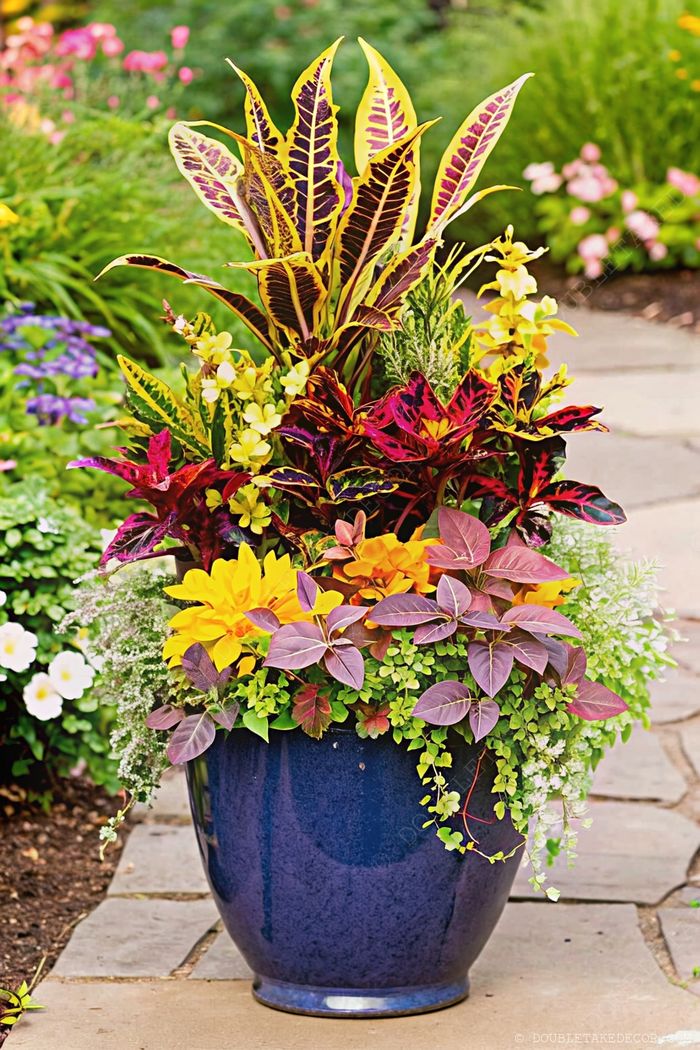
Create a dynamic focal point with a large ceramic planter filled with contrasting foliage and flowers. Combine tall, architectural plants with trailing varieties for visual interest. Position taller plants in the center or back, and arrange complementary colors for maximum impact. Water thoroughly but ensure proper drainage to prevent root rot.
Cottage-Style Entrance Garden Display
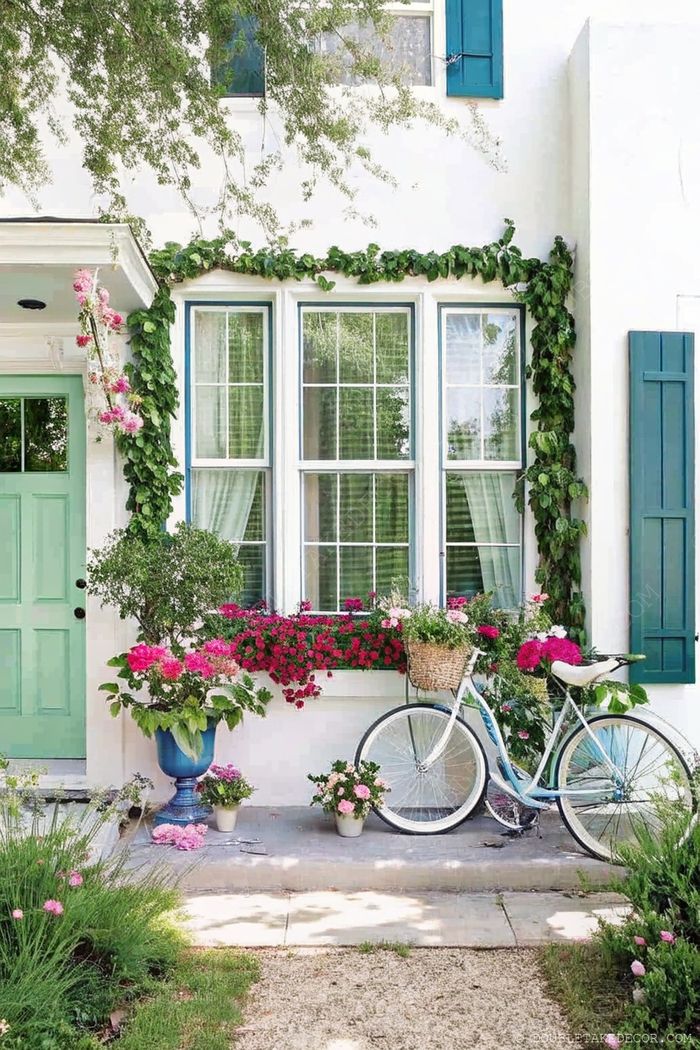
Create a welcoming front entrance by combining various pot sizes and plant heights. Arrange colorful planters around your doorway, incorporating climbing vines for vertical interest. Add hanging baskets near windows for dimension, and use architectural elements like a decorative bicycle as a unique display point. Maintain color harmony by selecting complementary flower hues for visual cohesion.
Colorful Birdhouse Garden Display
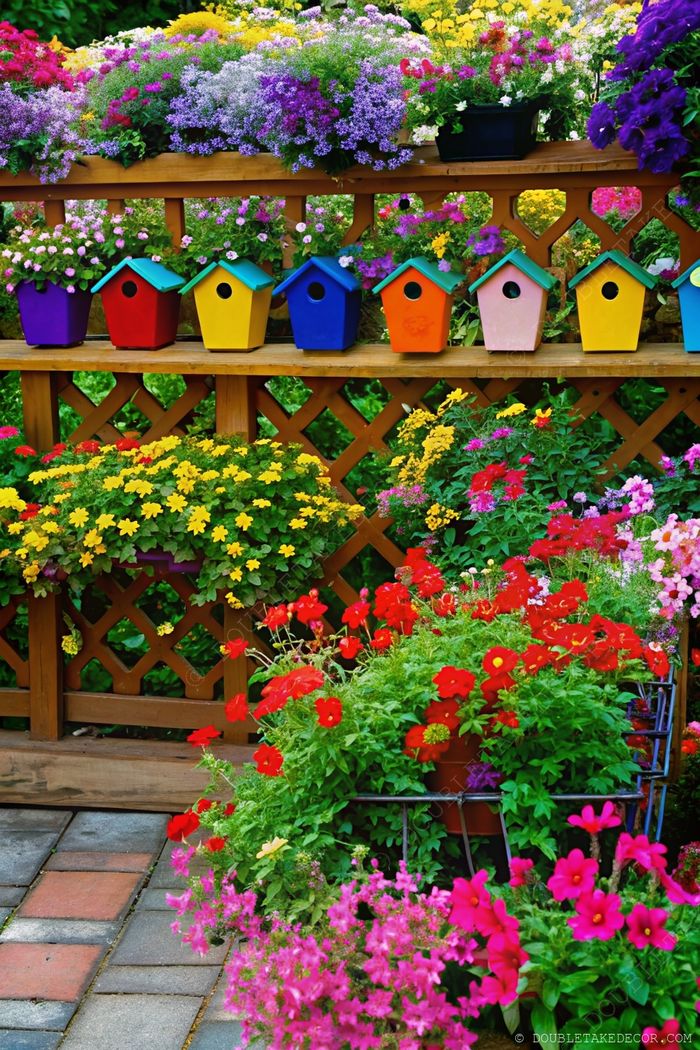
Create a charming focal point by pairing bright birdhouses with cascading flowers against a wooden lattice. Arrange pots at varying heights for visual interest, and mix flower colors for a vibrant, cohesive look. Use brick pathways to define the space and draw visitors into your garden display. This arrangement combines whimsy with practical garden elements.
Layered Garden Path Display
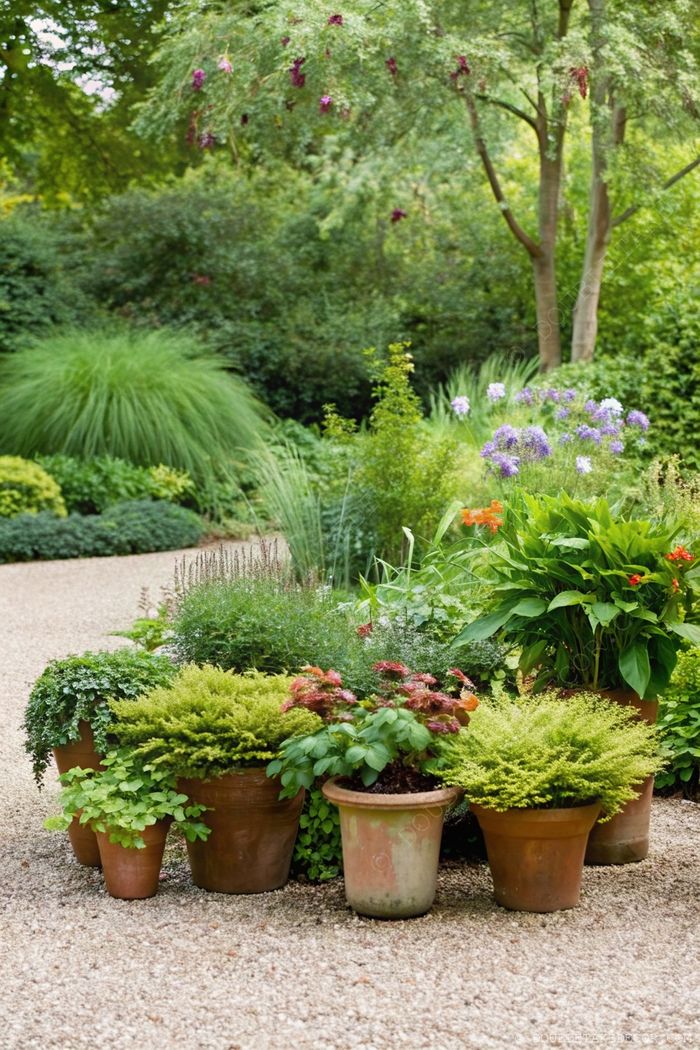
Arrange terracotta pots of varying heights along gravel pathways to create visual interest. Place taller ferns and grasses at the back with flowering plants in front for a natural layered effect. Use this arrangement to frame walkways while maintaining accessibility. The varied textures and heights create depth while complementing the surrounding landscape.
FAQ
What Are Some Creative Potted Plant Arrangement Ideas?
Creative potted plant arrangements have the power to rejuvenate outdoor spaces. By incorporating colorful blooms and rich foliage, you can infuse life into porches or patios. Embrace the seasons by choosing native plants for a natural vibe or opting for heat-tolerant annuals during summer months. Containers that stand out, such as galvanized tubs or vintage watering cans, add distinct charm and character. Mixing plants of different heights and textures enhances visual intrigue, while pairing contrasting foliage with vibrant flowers creates striking displays.
- consider grouping pots of varying sizes together for added depth and dimension,
- combine trailing plants with upright varieties to achieve a lush cascading effect,
- select containers that align with your design vision; items like antique buckets or decorative bowls can provide unique styles.
- it’s essential to keep in mind each plant’s specific sunlight and water requirements to ensure they thrive.
- for an extra touch of creativity, think outside the box by using unconventional items like wheelbarrows or metal lanterns as planters.
- fill them with seasonal plants or flowers to craft eye-catching vignettes.
- this approach not only highlights the beauty of your arrangements but also injects personal flair into your outdoor decor through inventive container choices and imaginative combinations.
How Can Container Gardening Enhance Outdoor Spaces?
Container gardening breathes life into any outdoor space, whether it’s a cozy balcony or an expansive patio. It introduces a splash of vibrant colors, diverse textures, and delightful fragrances. With decorative pots or even unconventional choices like galvanized tubs, you can craft captivating displays that serve as focal points, enhancing the charm of your outdoor decor.
One major perk of container gardening is its flexibility. Plants can be easily rearranged to ensure they receive optimal sunlight while maintaining their visual appeal. This adaptability keeps your space fresh and engaging throughout the year. By grouping containers together, you not only amplify visual interest but also make efficient use of available space, ensuring your environment remains inviting all year round.
What Are the Best Plant Combinations for Containers?
Mixing flowers and foliage in containers can transform them into captivating plant displays. For a striking effect, pair bold leaves like those of the Acalypha with the vibrant hues of petunias or zinnias. To maintain their appeal through every season, consider combining:
- heat-tolerant annuals such as angelonia,
- cool-season favorites like pansies.
Enhance visual interest by incorporating plants of varying heights and growth patterns; trailing species alongside upright ones create a rich tapestry of textures and forms, ensuring your arrangement remains lush and dynamic year-round.
What Is the Best Growing Medium for Potted Plants?
For potted plants, the perfect growing medium is a soilless mix designed to provide excellent aeration and support for root development. Unlike traditional garden soil, which can retain excessive moisture and become compacted, leading to issues like root rot, a soilless mix offers a much better alternative. Typically composed of:
- peat moss,
- perlite,
- vermiculite.
This blend effectively maintains optimal moisture levels while ensuring roots have access to air. This balance not only prevents waterlogging but also promotes robust plant growth.
To help your plants flourish, remember to keep their containers well-watered and fertilize them regularly. This attentive care replenishes essential nutrients needed for vibrant blooms and lush foliage. Additionally, using a soilless mix significantly reduces problems with pests and diseases that are common in regular soil, providing a healthier environment for your beloved plants.
Why Should You Consider a Soilless Mix for Container Gardening?
Opting for a soilless mix in container gardening brings numerous advantages. Its superb drainage and airflow capabilities help avert root rot, a frequent problem with traditional garden soil. Plus, these blends are lightweight, making it simple to relocate containers as needed. They also often come enriched with nutrients that foster robust plant growth.
- peat moss,
- perlite,
- vermiculite.
This combination retains moisture while allowing roots to breathe adequately. Moreover, they tend to repel pests and diseases more effectively than regular soil, fostering a healthier environment for plants.
Using such a mix can result in thriving growth and stunning blooms in your container gardens. Coupled with proper watering and fertilization practices, it significantly boosts plant health and productivity in your gardening endeavors.
How Important Are Drainage Holes in Garden Containers?
Drainage holes in garden containers play a crucial role in maintaining plant health. They allow excess water to escape, which prevents waterlogging and root rot. Without proper drainage, roots can become saturated and deprived of oxygen, ultimately harming the plant.
When choosing or creating containers, it’s important to ensure they have sufficient drainage holes to support robust root development. If you happen to use a container lacking these holes, consider:
- adding gravel at the bottom,
- opting for a soilless mix to better manage moisture levels.
- These strategies promote healthy plant growth and help prevent common issues associated with overwatering in container gardening.
Should You Use Traditional Clay Pots or Decorative Pots?
Clay pots and decorative containers both bring distinct advantages to container gardening:
- clay pots allow air to flow around plant roots, promoting healthy growth, while their natural appearance blends seamlessly into outdoor landscapes,
- decorative pots are available in a wide range of styles and materials, offering gardeners the chance to express their personal style through design choices.
When deciding between these two options, consider your plant’s specific requirements. Think about factors like drainage and root aeration needs. Clay pots excel in drainage due to their porous nature but dry out more quickly, potentially requiring more frequent watering. Decorative pots vary widely; some may lack drainage holes or restrict airflow.
Incorporating both types can enhance your garden’s visual appeal. Use clay pots for plants that thrive with ample aeration and place decorative ones strategically as focal points or highlights in certain areas. This strategy seamlessly merges practicality with aesthetics.
What Are Unique Container Ideas for Potted Plants?
Transform plain areas into visually striking displays by thinking beyond the traditional plant pot. Get creative with unexpected items such as:
- galvanized tubs,
- old wheelbarrows,
- wooden crates for a charming rustic vibe.
Repurposing objects like watering cans or teacups can add a whimsical touch to your garden.
If you’re looking to save space and elevate your gardening game, explore vertical options. Wall-mounted planters crafted from:
- old wooden cutting boards,
- stackable designs
offer practical solutions while infusing character into any setting. By selecting unconventional containers, you not only make efficient use of space but also express your personal style and creativity through unique plant arrangements.
What Are the Benefits of Using Oversized Urns in Arrangements?
Incorporating large urns into your garden or patio can be highly beneficial. They serve as striking focal points, capturing attention and leaving a lasting impression. Thanks to their roomy interiors, these urns can accommodate a variety of plants, creating a lush and vibrant display that allows for an intriguing mix of species.
Additionally, the grandeur of oversized urns adds an elegant and sophisticated touch to any outdoor space, making them ideal for formal gardens or entrances. Their substantial weight ensures stability during windy conditions, keeping your plant arrangements secure. By blending beauty with functionality, these urns are an excellent choice for elevating the design of your garden.
What Are the Advantages of Using Galvanized Buckets?
Galvanized buckets make excellent containers for potted plants, bringing a rustic charm that complements both country and modern gardens. Their durability allows them to withstand outdoor weather conditions without deteriorating. Typically, these buckets offer good drainage, especially if you add holes to the bottom to prevent water from pooling, which promotes healthy root growth.
Moreover, galvanized buckets are incredibly versatile. They can accommodate a wide range of plants, including flowers and herbs, making them a practical option for container gardening. Their adaptability ensures they seamlessly integrate into various garden designs and plant arrangements.
How Can a Plant Caddy or Stand Benefit Your Arrangement?
A plant caddy or stand offers a convenient way to move heavy or large containers, ensuring your plants receive optimal sunlight. It also allows you to effortlessly change their arrangement. Elevating containers on a stand not only enhances visual appeal but also simplifies plant care, as there’s no need to bend over. Furthermore, it aids in drainage by letting excess water escape, thus preventing waterlogging. By using a plant caddy or stand, you enhance both the functionality and appearance of your potted plants.
How Does Layering Improve Potted Plant Arrangements?
Incorporating layers into potted plant arrangements enhances both their depth and visual appeal. Tall plants stand out as the main attractions, while medium-sized and trailing varieties fill in empty spaces and gently blend the edges. This approach not only ensures that every plant receives ample light by preventing taller ones from overshadowing the shorter ones, but also fosters better air circulation for overall plant health. The result is a lively, cohesive display that draws attention with its rich and vibrant look.
What Role Do Colorful Blooms Play in Potted Plant Arrangements?
Vibrant flowers play a crucial role in potted plant arrangements, immediately drawing attention and adding visual allure. As the centerpiece, they elevate the overall appearance of the arrangement. By incorporating complementary or contrasting hues, one can achieve a dynamic style that evolves with the seasons. These blossoms also evoke emotions and create an inviting atmosphere in outdoor spaces. Additionally, including flowers of various shapes and sizes introduces texture and depth, further enhancing their appeal.
What Is a Foliage Container Garden and How Is It Created?
A foliage container garden highlights the charm of leaves and their textures rather than flowers. To create one:
- select plants with a variety of leaf colors, such as green or variegated patterns,
- choose intriguing shapes,
- mix different textures by combining broad leaves with fine, feathery ones.
Layering these plants in a container provides a lush display that remains attractive throughout the season, even without any blooms. This garden style is perfect for shaded areas or for those who prefer a low-maintenance design.
What Are Heat-Tolerant Annuals and How Can They Be Used?
If you’re looking to spruce up your summer container garden, heat-tolerant annuals are a fantastic choice. These resilient plants not only thrive in soaring temperatures but also endure drought, ensuring vibrant blooms even when conditions get tough. Consider incorporating:
- angelonia,
- zinnias,
- petunias.
These plants provide a splash of continuous color and excitement throughout the season. By opting for these hardy options, you can enjoy lively displays that withstand even the hottest days of summer.
How Do Seasonal Arrangements Affect Plant Selection?
Selecting plants according to the seasons is vital, as each type thrives during specific times of the year. In spring, for instance, pansies and tulips bloom beautifully in the cooler temperatures. As summer arrives, petunias and zinnias take center stage with their ability to withstand the heat. Come fall, chrysanthemums and ornamental grasses add a splash of autumnal color and texture to your garden. Even in winter, evergreens and seasonal decorations ensure that your outdoor space remains captivating.
By aligning your plant choices with the seasons, you not only reflect nature’s changing scenery but also provide an environment where each plant can flourish. This strategy keeps your garden lively and attractive throughout the year.
What Are the Best Seasonal Flowers for Containers?
Selecting the right seasonal flowers for containers can keep your arrangements vibrant and appealing all year long.
- in spring, you can’t go wrong with the bright hues of pansies, tulips, and snapdragons,
- as summer rolls in, shift to heat-loving annuals like petunias, zinnias, and angelonia to withstand the higher temperatures,
- when autumn arrives, infuse your garden with the rich colors of chrysanthemums, ornamental kale, and asters,
- even in winter’s chill, evergreens such as hellebores and winter pansies provide greenery and blossoms.
By thoughtfully choosing these plants, your container displays will remain fresh and captivating throughout every season.
How Can You Incorporate Fall Planter Ideas into Your Garden?
Bringing fall planters into your garden invites the vibrant hues and textures of the season to shine. Flowers like chrysanthemums, ornamental cabbages, and pansies burst with color, creating a lively display. To amplify the autumn atmosphere, consider adding pumpkins or gourds. Arrange containers thoughtfully for a cohesive appearance, playing with different heights and textures to catch the eye. Incorporating natural elements such as hay bales or rustic wooden crates can further enhance your fall decor, making it both inviting and in tune with the season. These touches not only elevate your garden’s beauty but also infuse it with a touch of autumn charm.
What Are Some Patio and Balcony Planter Ideas?
Patio and balcony planters are designed to maximize space while enhancing aesthetics. Vertical gardening, using techniques like wall-mounted planters or tiered stands, efficiently utilizes compact areas. Hanging baskets filled with trailing plants introduce greenery without occupying floor space. By combining colorful annuals with perennials, you ensure your display remains vibrant throughout the year. Grouping containers of varying heights and sizes not only creates visual interest but also enhances the overall appearance. To make your outdoor area more inviting, consider adding charming decorations such as lanterns or garden art.
What Are Effective Outdoor Plant Arrangements for Privacy?
For a touch of privacy in your outdoor space, consider crafting plant arrangements using tall and dense varieties that naturally screen off areas. Container gardens filled with upright selections such as ornamental grasses, towering perennials, or shrubs can work wonders in obstructing views. By layering plants of varying heights, you not only maintain seclusion but also add visual depth to the scene. Trellises adorned with climbing plants serve as effective vertical dividers, while clustering containers together creates a vibrant green wall. This approach not only enhances the beauty of your garden but also ensures a sense of seclusion.
How Can Rustic Garden Containers Add Charm to Your Space?
Rustic garden containers bring a natural, earthy vibe to outdoor spaces. Typically crafted from materials like wooden crates, galvanized buckets, and terracotta pots, they evoke nostalgia and warmth, making gardens feel more inviting. These containers can house a variety of plants, from vibrant flowers to lush greenery, enhancing the garden’s character. Their imperfections and textures add charm, creating a cozy atmosphere that feels welcoming. By blending rustic elements with nature’s landscapes, you create a harmonious setting that beautifully complements any outdoor area.
How Can Vignettes Transform Garden Containers?
Vignettes transform garden containers into captivating displays that narrate a story or evoke particular moods. By clustering pots with complementary plants, colors, or ornaments, you achieve a cohesive aesthetic. Imagine a vignette featuring herbs, decorative stones, and rustic pots—it radiates the charm of a quaint kitchen garden. This approach allows for creativity and personalization, enabling you to arrange plants in a way that mirrors your unique style. Vignettes enhance the visual allure of your garden by introducing layers of interest and inviting discovery. This technique not only showcases the beauty of individual containers but also presents the entire arrangement as a unified work of art within your outdoor space.
What Are the Benefits of Grouping Containers?
Arranging containers together in a garden offers numerous advantages. It boosts visual charm, crafting eye-catching displays that draw attention and add dimension to your space. Clustering pots is an excellent way to maximize limited areas like patios or balconies.
- grouping plants helps retain soil moisture, fostering a microclimate that reduces watering frequency,
- this setup simplifies maintenance as it allows for simultaneous watering and fertilizing of multiple plants, saving both time and effort,
- when arranged collectively, plants benefit from adequate sunlight and air circulation, promoting healthier growth,
- this method fosters a cohesive garden design, giving you the freedom to experiment with various plant combinations and decorative pots,
- ultimately, this strategy not only improves plant care but also elevates the aesthetic appeal of your outdoor area.
How Can You Create DIY Outdoor Planters?
Creating your own outdoor planters is both an enjoyable and rewarding activity. Begin by selecting materials such as:
- wooden pallets,
- old crates,
- recycled items like tin cans and buckets.
Ensure these containers have drainage holes to prevent water from accumulating. You might also want to paint or decorate them to complement your outdoor aesthetic.
Next, fill the containers with a suitable growing mix that provides good airflow while retaining moisture effectively. Choose plants that thrive in your local climate and suit your personal preferences. Incorporating unique designs or themes into your planters adds character to your garden and allows you to express your creativity.
For added visual interest, consider using unconventional items like:
- galvanized tubs,
- vintage wheelbarrows.
By following these steps, you’ll create custom planters that are not only functional but also elevate the beauty of your outdoor space with imaginative container selections and creative plant pairings.
Ideas Creativas para Arreglos de Plantas en Macetas que Iluminarán tu Espacio
Idées créatives d’arrangements de plantes en pot pour illuminer ton espace
Kreative Ideen für Topfpflanzen-Arrangements, die deinen Raum zum Strahlen bringen
Kreatív cserepesplánta-elrendezési ötletek, amelyek feldobják a teredet
Kreatívne nápady na aranžovanie kvetináčových rastlín na rozjasnenie tvojho priestoru
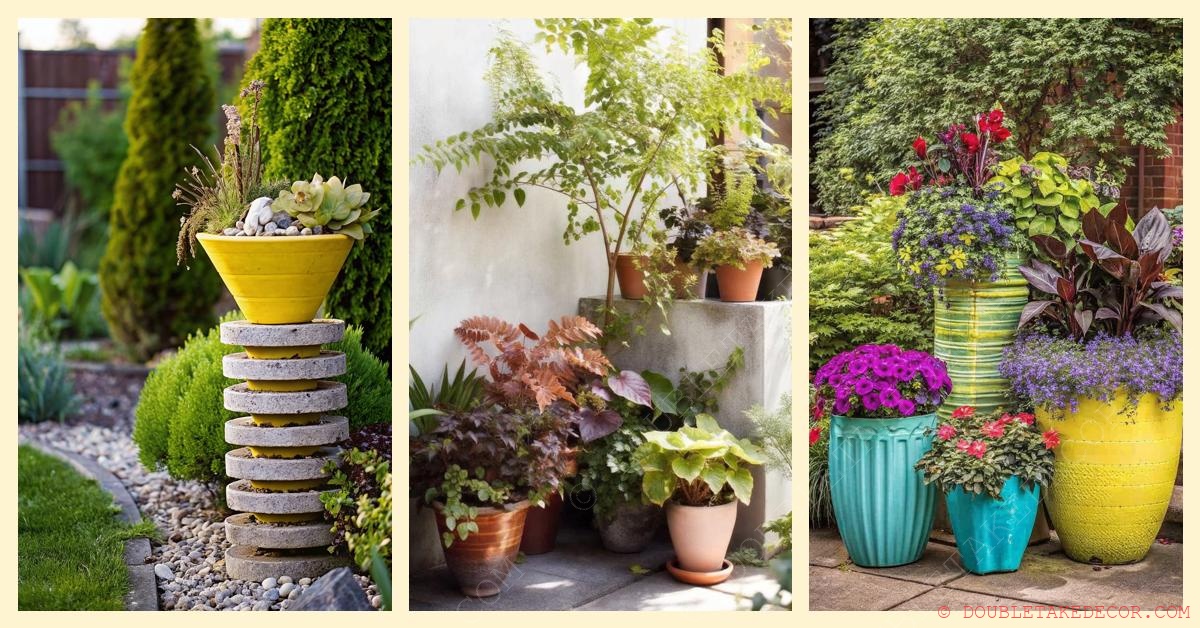
Creative Potted Plant Arrangement Ideas to Brighten Your Space
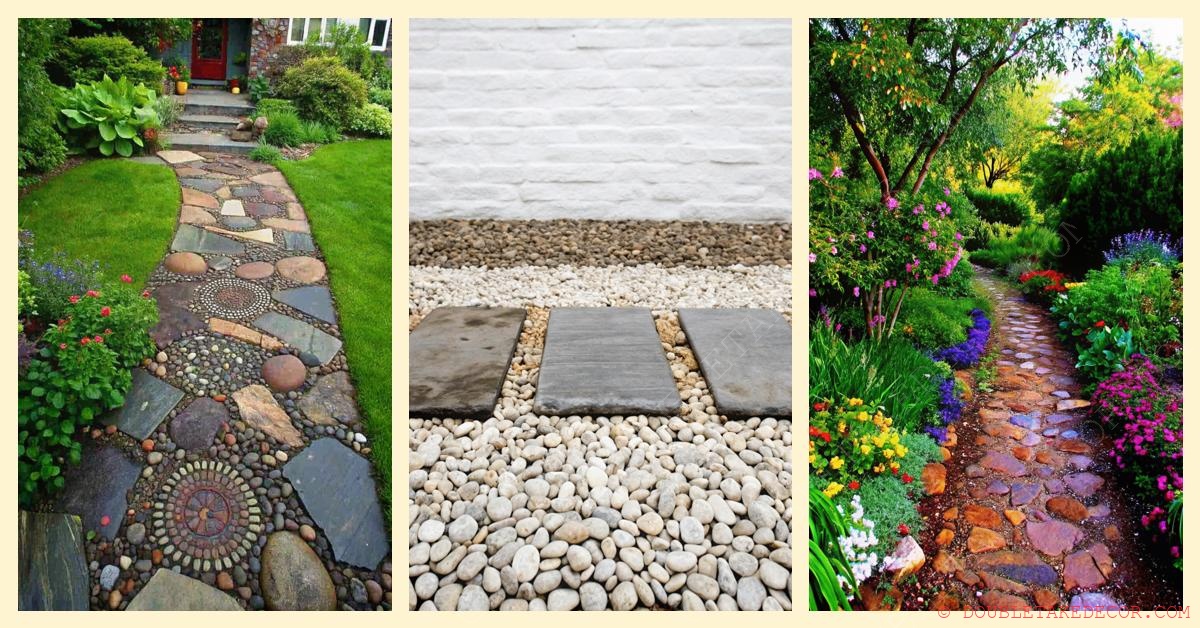
Enhance Your Garden Path with Beautiful Stepping Stones
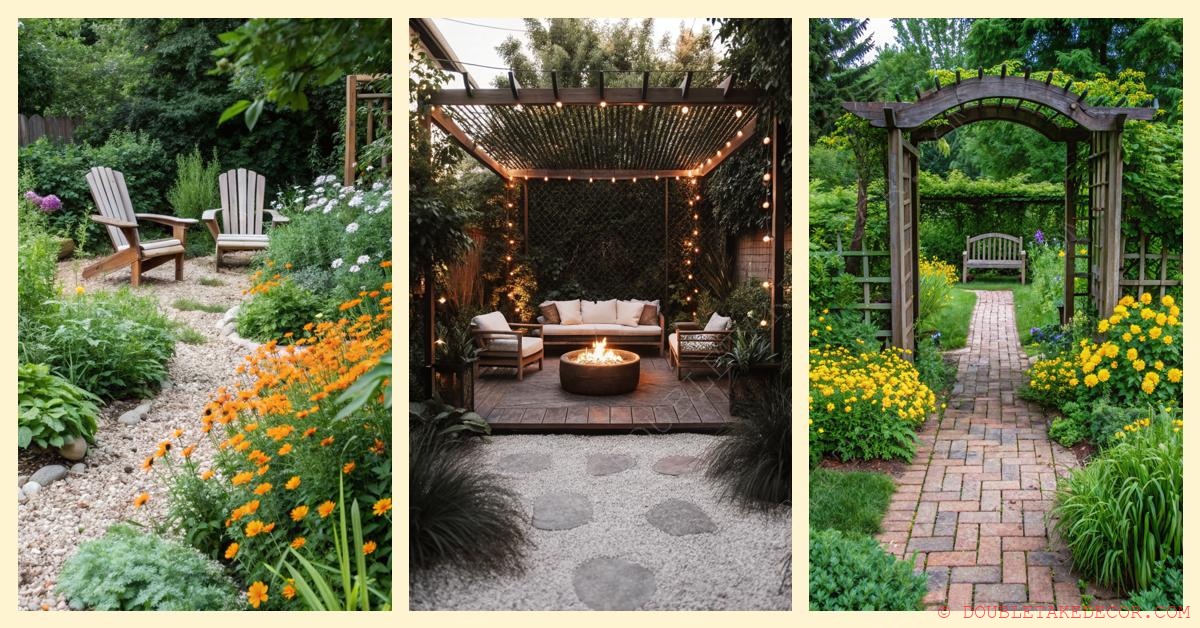
Transform Your Backyard with a Cozy Garden Nook
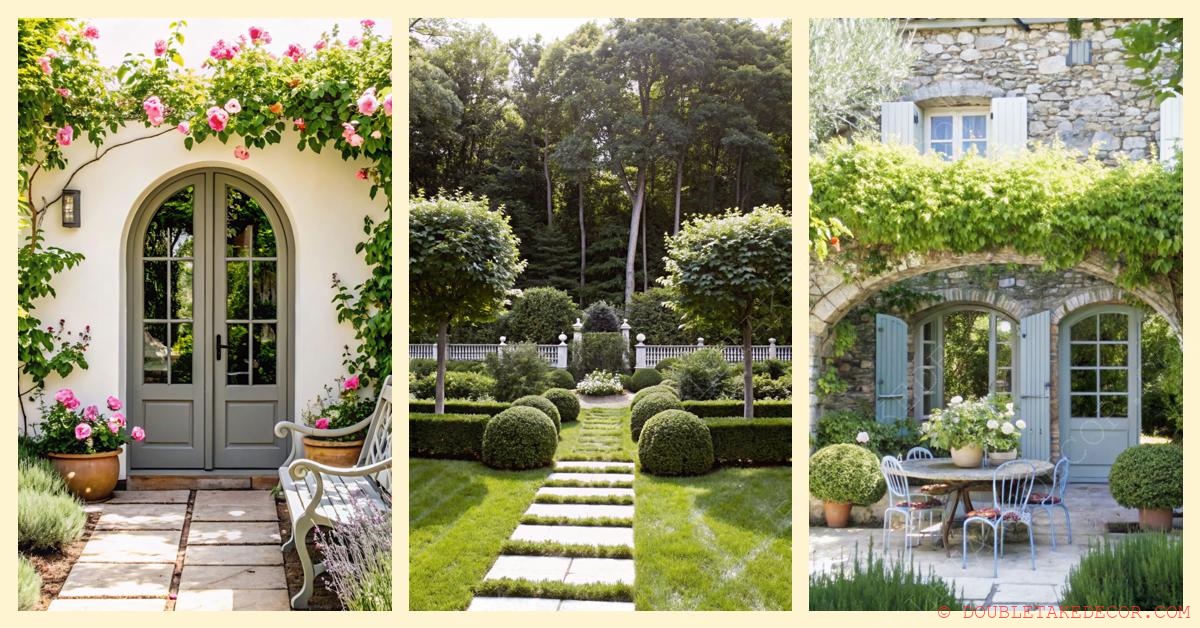
Creating Your Own French Garden: Design and Inspiration
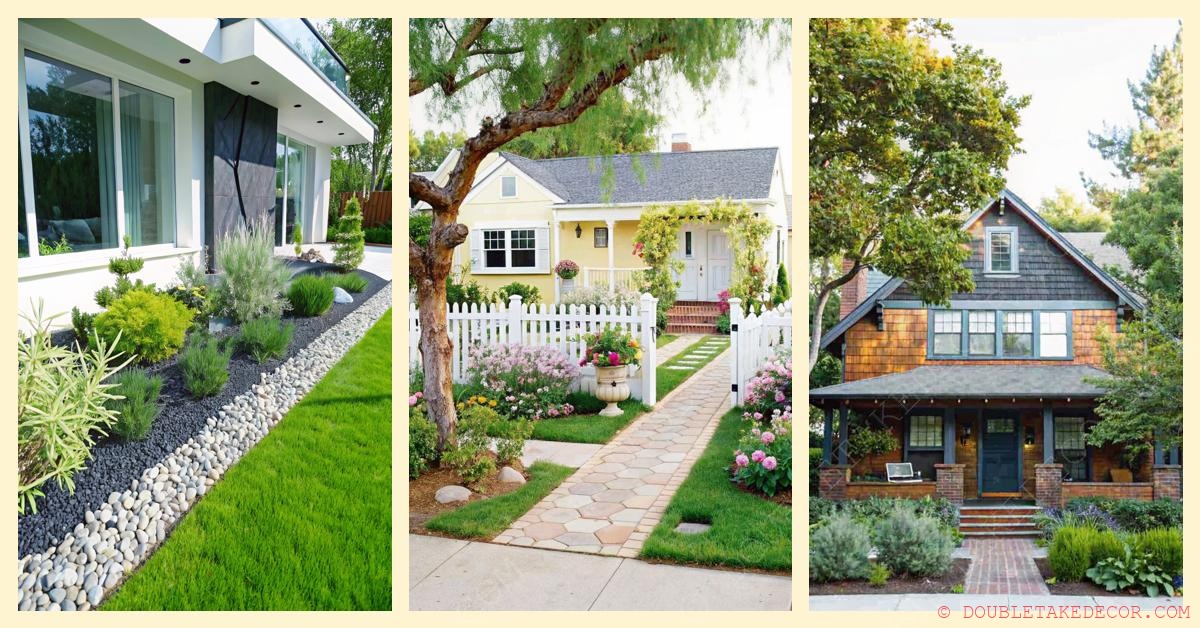
Transform Your Curb Appeal: Inspiring Front of Home Landscaping Ideas
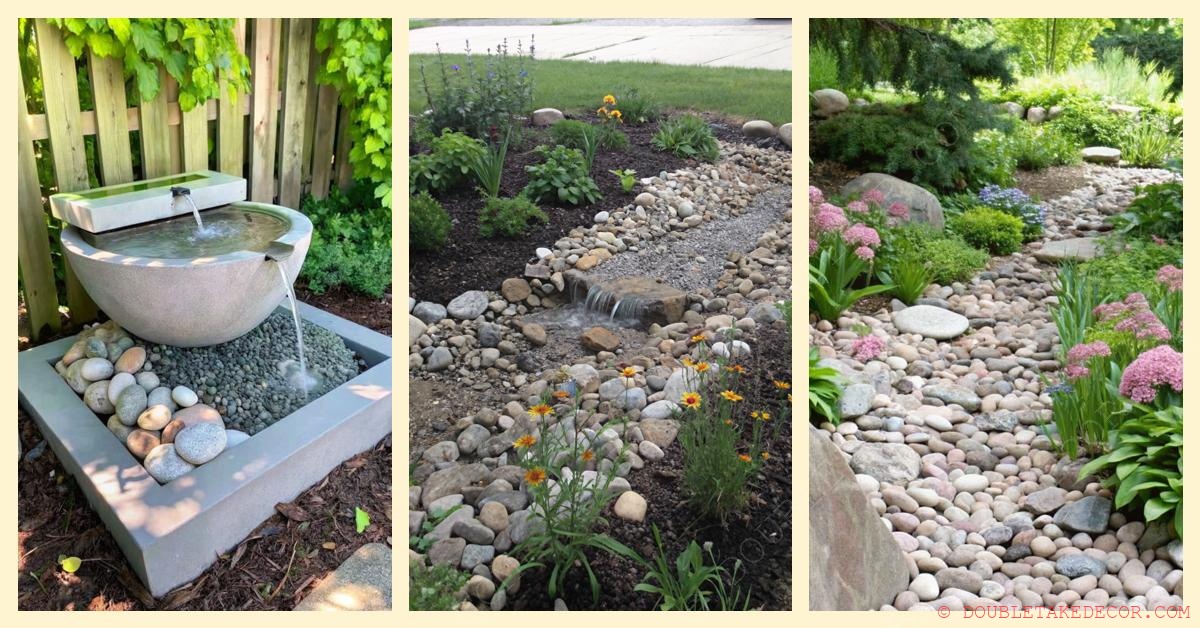
Innovative Rainscaping Ideas for a Sustainable Garden
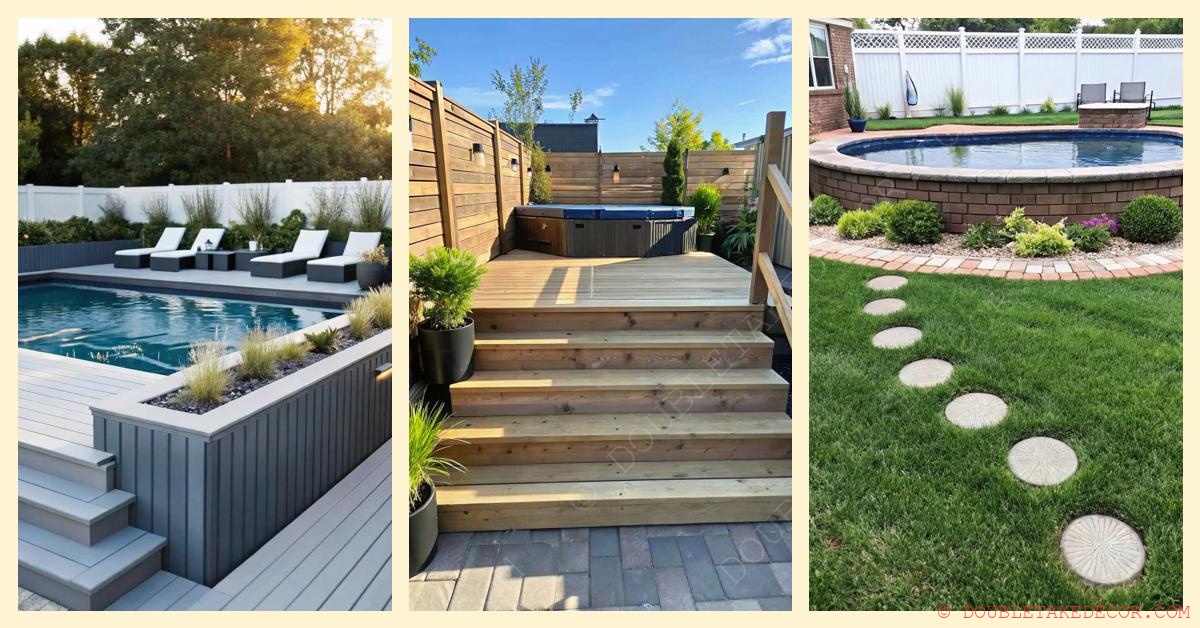
Stunning Above Ground Pool Ideas to Transform Your Backyard
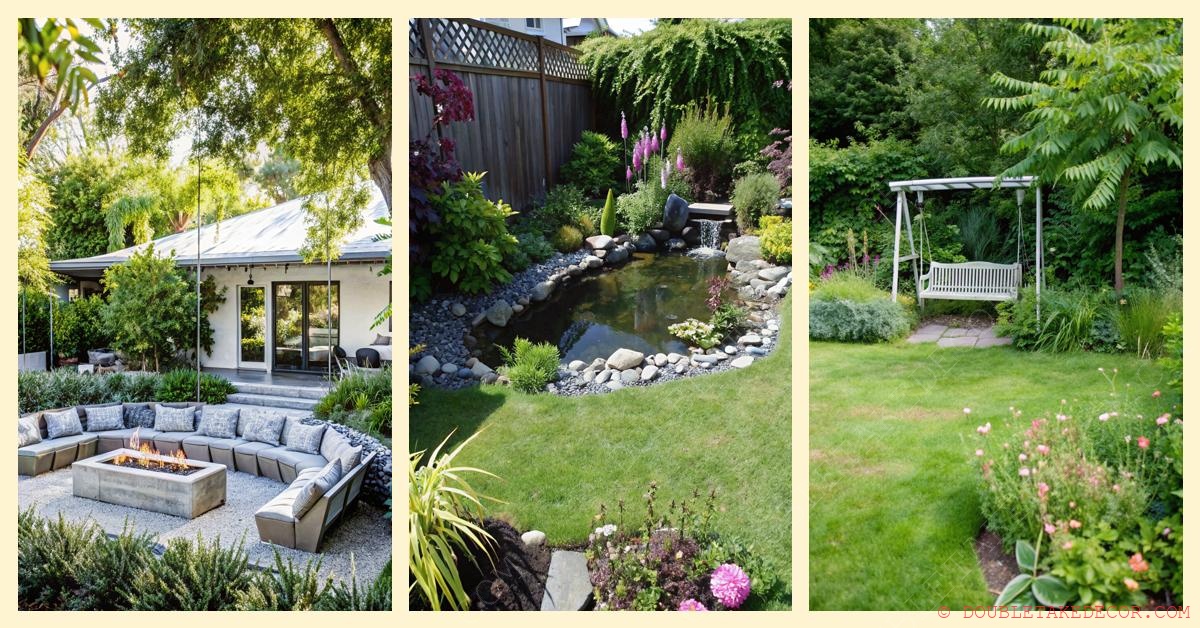
Ultimate Guide to Crafting Your Perfect Backyard Layout
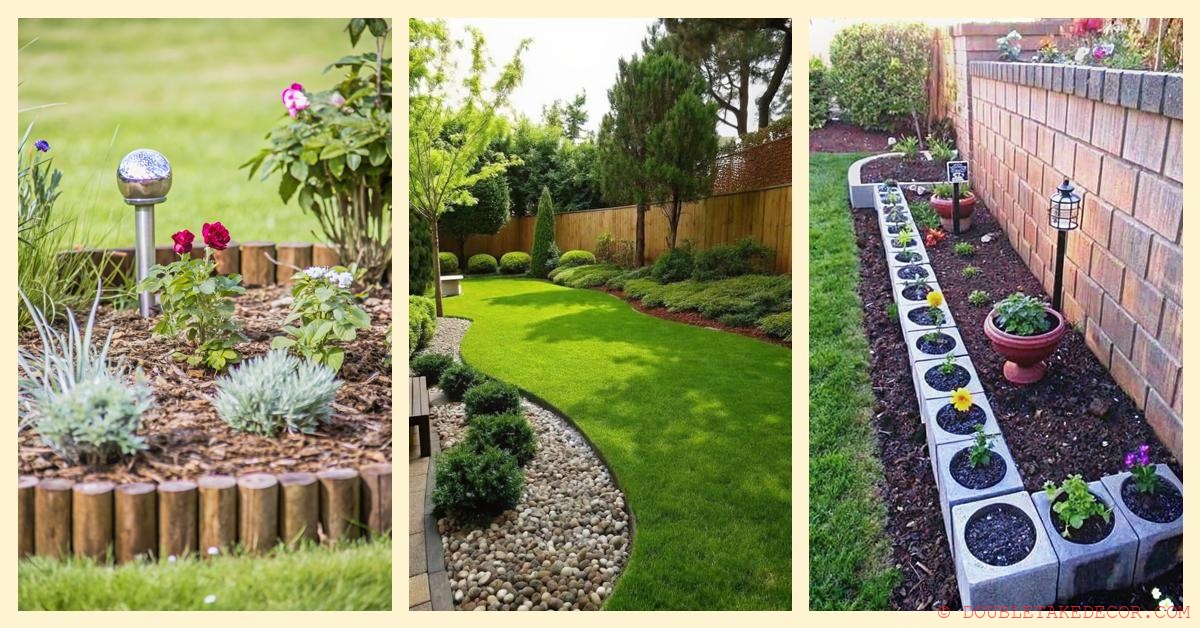
Transform Your Garden with Beautiful Edging Ideas
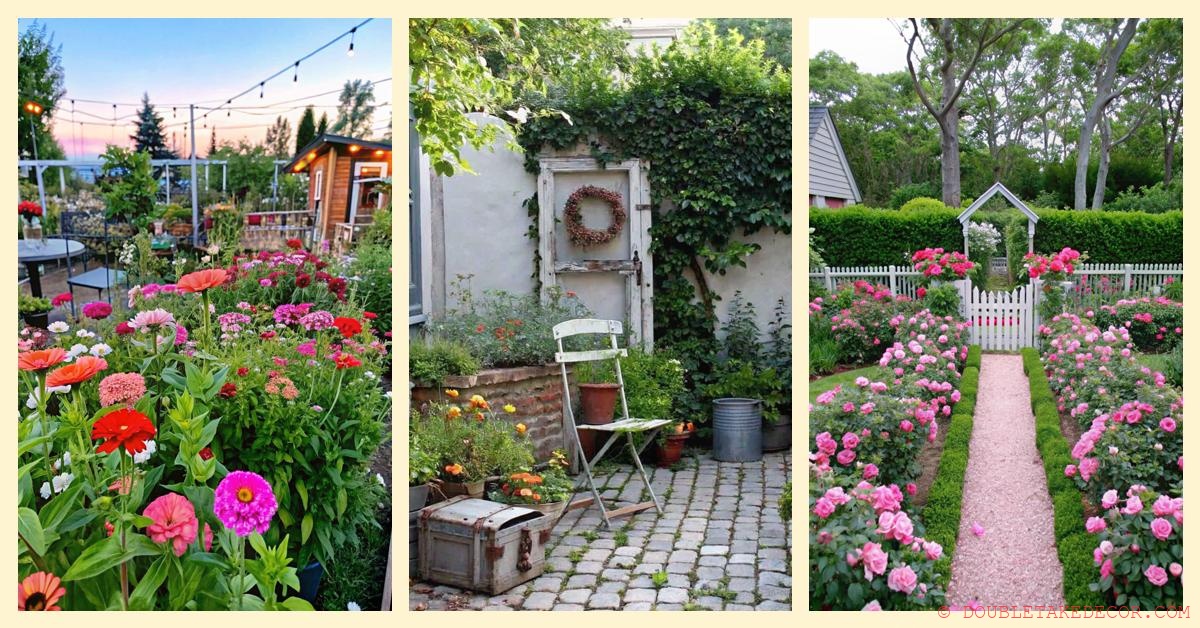
Transform Your Outdoor Space with Shabby Chic Garden Ideas
